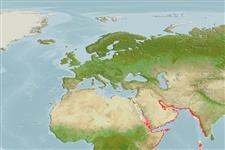>
Eupercaria/misc (Various families in series Eupercaria) >
Sparidae (Porgies)
Etymology: Acanthopagrus: Greek, akantha = thorn + Greek, pagros, a kind of fish (Ref. 45335); arabicus: Named for its type locality, the Arabian Sea including The Gulf..
Environment: milieu / climate zone / depth range / distribution range
Οικολογία
Θαλασσινό(ά); εύρος βάθους ? - 50 m (Ref. 11441). Tropical
Western Indian Ocean: from Duqum, southern Oman to Qatar, off the coasts of Kuwait (probably including Iran and Pakistan), to Trivandrum, south-western India.
Μέγεθος / Βάρος / Age
Maturity: Lm ? range ? - ? cm
Max length : 34.5 cm SL αρσενικό/απροσδιόριστο; (Ref. 4606); common length : 30.0 cm TL αρσενικό/απροσδιόριστο; (Ref. 3507)
Short description
Μορφολογία | Μορφομετρία
Ραχιαίες άκανθες (συνολικά): 11 - 12; Μαλακές ραχιαίες ακτίνες (συνολικά): 10-11; Εδρικές άκανθες 3; Μαλακές εδρικές ακτίνες: 8. This species is distinguished from its congeners by the following set of characters: deep body, 2.03-2.38 (mean 2.21); D XI,11 or XII,10; scale rows between fifth dorsal-fin spine base and lateral line 4 1/2, scale rows above lateral line 4 1/2-5 1/2, scale rows below 12 1/2-13 1/2; second anal-fin spine [17.5-24.2% (mean 20·5%) of SL], 1.31-1.52 (mean 1.39) in 2AS/3AS; pored lateral-line scales 42-45 (mean 43.9); first soft dorsal-fin ray slightly longer than last dorsal-fin spine; pelvic and anal fins vivid or strong yellow, lower caudal-fin lobe yellow (lighter or whitish yellow in larger adults); no black streaks proximally on inter-radial membranes between yellow anal-fin rays; clear black
blotches are usually absent just beneath inter-radial membranes between dorsal-fin rays but upper
dorsal-fin membrane often with darker margin; at the origin of lateral line a weak diffuse dark blotch usually covering first pored lateral-line scale, continuing as a dense dark shading over upper part of posterior opercle (Ref. 93743).
Feeds mainly on echinoderms, worms, crustaceans and mollusks. Mainly exploited by artisanal fisheries. Sold fresh in markets (Ref. 3507).
Life cycle and mating behavior
Γεννητική Ωρίμανση | Αναπαραγωγή | Γεννοβολία | Αβγά | Γονιμότητα | Προνύμφες
Iwatsuki, Y., 2013. Review of the Acanthopagrus latus complex (Perciformes: Sparidae) with descriptions of three new species from the Indo-West Pacific Ocean. J. Fish Biol. 83(1):64-95. (Ref. 93743)
IUCN Red List Status (Ref. 130435)
Human uses
αλιεία: Εμπορικό(ά)
Περισσότερες πληροφορίες
Κοινά ονόματαΣυνώνυμαΜεταβολισμόςΘηρευτέςΟικοτοξικολογίαΑναπαραγωγήΓεννητική ΩρίμανσηΓεννοβολίαΣυναθροίσεις γεννοβολίαςΓονιμότηταΑβγάEgg development
ΑναφορέςΥδατοκαλλιέργειεςΠροφίλ υδατοκαλλιέργειαςΣτελέχοιΓενετικήElectrophoresesΚληρονομικότηταΑσθένειεςΜεταποίησηNutrientsMass conversion
Εργαλεία
Special reports
Download XML
Διαδικτυακές πηγές
Estimates based on models
Preferred temperature (Ref.
123201): 24.6 - 29.3, mean 27.2 °C (based on 186 cells).
Phylogenetic diversity index (Ref.
82804): PD
50 = 0.5000 [Uniqueness, from 0.5 = low to 2.0 = high].
Bayesian length-weight: a=0.02512 (0.01448 - 0.04356), b=2.95 (2.81 - 3.09), in cm total length, based on LWR estimates for this species & Genus-body shape (Ref.
93245).
Τροφικό Επίπεδο (Ref.
69278): 3.2 ±0.3 se; based on diet studies.
Ελαστικότητα (Ref.
120179): Μεσαίο(α), ελάχιστος χρόνος για διπλασιασμό πληθυσμού 1,4 - 4,4 έτη (Preliminary K or Fecundity.).
Fishing Vulnerability (Ref.
59153): Low to moderate vulnerability (32 of 100).
